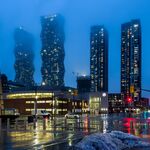Based on this image, here is a lot of variability between station usage (2016) and density. If we were to graph the ratios, ridership vs density would look something like this:
It looks like there is a trend, but when your correlation coefficient is so low, you cannot make an association with housing density and actual station ridership.
Notice how some the stations with the largest ridership (Finch, Don Mills, Sheppard-Yonge, Sheppard West, Eglinton, Kennedy, Warden, A lot of the Spadina Line, Lawrence, York Mills, Broadview, Islington, Kipling) have some of the lower densities (In the case of Finch, Sheppard-Yonge, and Eglington, I can say their densities are low because their riderships are so high.
However, many stations with relatively high densities (Summerhill, Rosedale, Bayview, Bessarion, Spadina (University line), Woodbine, Greenwood, High Park, Castle Frank, Chester, Glencairn, Museum) have low ridership
The point is that you cannot make density == ridership associations because:
1. Not everyone takes the subway
2. Not everyone uses the subway daily
3. Many people have destinations along the subway
People will take the subway to destinations, not take the subway because it's close to them.







